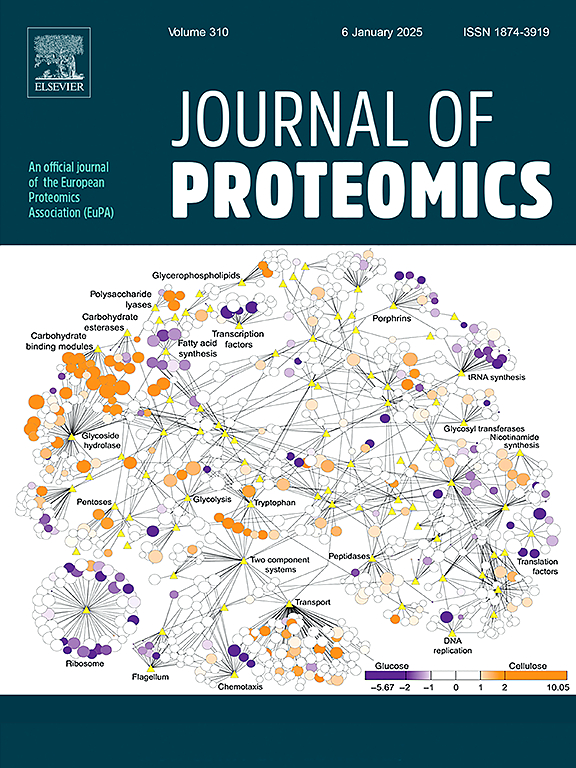酿酒酵母中TPS/TPP复合物的结构动力学:来自交联质谱和计算模型的见解。
IF 2.8
2区 生物学
Q2 BIOCHEMICAL RESEARCH METHODS
引用次数: 0
摘要
海藻糖是一种普遍存在的双糖,对包括致病真菌在内的细胞活力起着至关重要的作用,使其合成途径成为抗真菌药物设计的关键靶点。海藻糖-磷酸合成酶(TPS)/海藻糖-磷酸磷酸酶(TPP)复合物的结构细节仍然是难以捉摸的。关于TPS/TPP复合物的结构和拓扑结构的信息仍然很少,这极大地限制了对海藻糖合成机制的理解。本研究首次概述了40 °C热冲击后Saccharomyces cerevisiae TPS/TPP复合物内部的相互作用,并通过交联质谱(XL-MS)和计算模型进行了分析。我们的交联数据证实了uniprot可用于分离亚基的AlphaFold模型。固有无序区域被认为是调控亚基,而交联分析强调Tsl1的无序n端是组装TPS/TPP复合体的重要区域。最后,磷酸化预测表明,n端tps3紊乱区域和磷酸酶样结构域被优先磷酸化,触发Tps2活性抑制,阻止T6P积累。这些见解增强了我们对TPS/TPP复合物的结构动力学和灵活性的理解,为潜在的治疗应用开辟了新的途径,对人类的毒性降低或没有毒性。意义:本研究有助于全面了解酵母中参与海藻糖合成的关键酶系统TPS/TPP复合物的结构。海藻糖在细胞活力和逆境适应中至关重要,特别是在致病真菌中,使其生物合成途径成为抗真菌药物开发的一个有希望的靶点。通过结合交联质谱(xls - ms)和计算模型,本研究揭示了TPS/TPP复合物的关键相互作用和动态特征,包括其调控亚基中可能参与复杂组装和热休克条件下调控的内在无序区域。此外,磷酸化预测揭示了Tps3上的紊乱区域如何参与调节Tps2活性以调节海藻糖-磷酸盐水平,从而为该复合体的功能动力学提供了见解。这项工作填补了理解海藻糖生物合成的关键知识空白,并为降低对人类细胞毒性的新型抗真菌策略铺平了道路。本文章由计算机程序翻译,如有差异,请以英文原文为准。

Structural dynamics of the TPS/TPP complex in Saccharomyces cerevisiae: Insights from cross-linking mass spectrometry and computational modeling
Trehalose, a ubiquitous disaccharide, plays a vital role in cell viability, including pathogenic fungi, making its synthetic pathway a key target for antifungal drug design. The structural details of the trehalose-phosphate synthase (TPS)/trehalose-phosphate phosphatase (TPP) complex, which is responsible for synthesizing trehalose, have remained elusive. Information on the structure and topology of the TPS/TPP complex remains scarce, significantly limiting the mechanistic understanding of trehalose synthesis. This study presents the first overview of the interactions within the Saccharomyces cerevisiae TPS/TPP complex following a 40 °C heat shock, analyzed by cross-linking mass spectrometry (XL-MS) and computational modeling. Our cross-linking data corroborate the UniProt-available AlphaFold models for isolated subunits. Intrinsically disordered regions are suggested for the regulatory subunits, while cross-linking analysis highlights the disordered N-terminus of Tsl1 as an important region in assembling the TPS/TPP complex. Finally, the phosphorylation prediction indicates that Tps3-disordered regions at the N-terminus and the phosphatase-like domains are preferentially phosphorylated, triggering the inhibition of Tps2 activity and halting T6P accumulation. These insights enhance our understanding of the structural dynamics and flexibility of the TPS/TPP complex, opening new avenues for potential therapeutic applications with diminished or no toxicity to humans.
Significance
This research contributes to a comprehensive structural understanding of the TPS/TPP complex in Saccharomyces cerevisiae, a key enzymatic system involved in trehalose synthesis. Trehalose is essential in cellular viability and stress adaptation, particularly in pathogenic fungi, making its biosynthetic pathway a promising target for antifungal drug development. By integrating cross-linking mass spectrometry (XL-MS) and computational modeling, this study uncovers critical interactions and dynamic features of the TPS/TPP complex, including the involvement of intrinsically disordered regions in its regulatory subunits possibly contributing to complex assembly and regulation under heat shock conditions. Furthermore, the phosphorylation predictions shed light on how disordered regions on Tps3 would participate in modulating Tps2 activity to regulate trehalose-phosphate levels, offering insights into the complex's functional dynamics. This work fills a crucial knowledge gap in understanding trehalose biosynthesis and paves the way for novel antifungal strategies with reduced toxicity to human cells.
求助全文
通过发布文献求助,成功后即可免费获取论文全文。
去求助
来源期刊

Journal of proteomics
生物-生化研究方法
CiteScore
7.10
自引率
3.00%
发文量
227
审稿时长
73 days
期刊介绍:
Journal of Proteomics is aimed at protein scientists and analytical chemists in the field of proteomics, biomarker discovery, protein analytics, plant proteomics, microbial and animal proteomics, human studies, tissue imaging by mass spectrometry, non-conventional and non-model organism proteomics, and protein bioinformatics. The journal welcomes papers in new and upcoming areas such as metabolomics, genomics, systems biology, toxicogenomics, pharmacoproteomics.
Journal of Proteomics unifies both fundamental scientists and clinicians, and includes translational research. Suggestions for reviews, webinars and thematic issues are welcome.
 求助内容:
求助内容: 应助结果提醒方式:
应助结果提醒方式:


